Spring Data Redis数据缓存 使用Spring Data Redis实现数据缓存的方法
JavaQ 人气:0引言
目前很多系统为了解决数据读写的性能瓶颈,在系统架构设计中使用Redis实现缓存,Spring框架为了让开发人员更加方便快捷的使用Redis实现缓存,对Redis的操作进行了包装。
0.缓存
个人理解的缓存是指用于存储频繁使用的数据的空间,关注点是存储数据的空间和使用频繁的数据。缓存技术,简单的说就是先从缓存中查询数据是否存在,存在则直接返回,不存在再执行相应的操作获取数据,并将获取的数据存储到缓存中,它是一种提升系统性能的重要方法。
1.Redis
Redis是一个开源的、内存存储key-value类型的数据结构服务器,可用作数据库、高速缓存和消息队列代理。它支持的数据类型有字符串、哈希表、列表、集合、有序集合等,同时通过Redis Sentinel提供高可用,通过Redis Cluster提供分区功能。
2.jedis
jedis是Redis的Java版客户端实现,也是官方推荐的Java版客户端。它封装了对Redis的各种操作,并且支持事务、管道及有jedis自身实现的分布式。
3.Spring Data Redis
Spring Data是Spring框架中的一个主要项目,目的是为了简化构建基于Spring框架应用的数据访问,包括非关系数据库、Map-Reduce框架、云数据服务等,另外也包含对关系数据库的访问支持。
Spring Data Redis是Spring Data项目中的一个主要模块,实现了对jedis客户端API的高度封装,使对Redis的操作更加便捷。
4.关系图
Redis、jedis、Spring Data Redis三者之间的关系图如下所示。
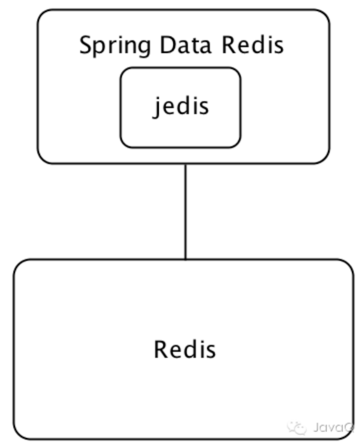
5.Spring Cache
从Spring3.1开始,Spring框架提供了对Cache的支持,提供了一个对缓存使用的抽象,通过在既有代码中添加少量它定义的各种 annotation,即能够达到缓存方法的返回对象的作用。提供的主要注解有@Cacheable、@CachePut、@CacheEvict和@Caching,具体见表1。
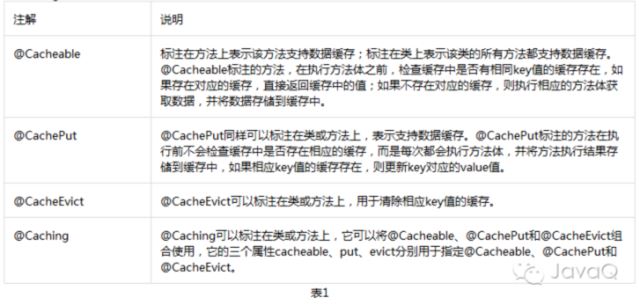
@Cacheable的常用属性及说明如表2所示。
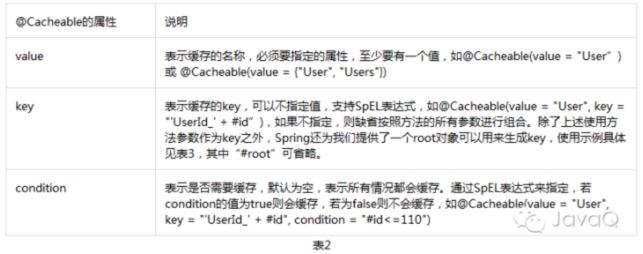
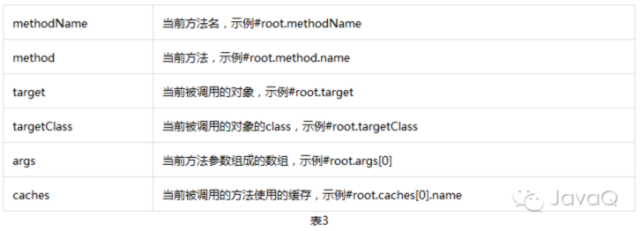
@CacheEvict的常用属性见表4。@CachePut的常用属性同@Cacheable。
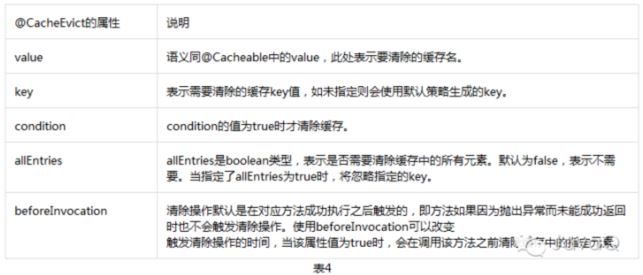
当需要在类上或方法上同时使用多个注解时,可以使用@Caching,如@Caching(cacheable = @Cacheable("User"), evict = {@CacheEvict("Member"), @CacheEvict(value = "Customer", allEntries = true)})
6.使用示例
下面使用Spring Data Reds、Redis和jedis实现一个简单的数据缓存。
1)依赖配置
示例使用了gradle,所以需要在build.gradle中加入如下依赖配置来管理所需要的jar。
compile "org.springframework.data:spring-data-redis:1.7.2.RELEASE" compile "redis.clients:jedis:2.7.2" testCompile "junit:junit:4.12"
2)Redis配置
示例连接的是本地的Redis,redis.properties配置如下。
# Redis settings redis.host=127.0.0.1 redis.port=6379 redis.pass= redis.dbIndex=0 redis.expiration=3000 redis.maxIdle=300 redis.maxActive=600 redis.maxWait=1000 redis.testOnBorrow=true
3)Spring配置
Spring的配置文件如下。
<?xml version="1.0" encoding="UTF-8" standalone="no"?>
<beans xmlns:xsi="http://www.w3.org/2001/XMLSchema-instance"
xmlns="http://www.springframework.org/schema/beans"
xmlns:context="http://www.springframework.org/schema/context"
xmlns:cache="http://www.springframework.org/schema/cache"
xsi:schemaLocation="http://www.springframework.org/schema/beans
http://www.springframework.org/schema/beans/spring-beans.xsd
http://www.springframework.org/schema/context http://www.springframework.org/schema/context/spring-context.xsd
http://www.springframework.org/schema/cache http://www.springframework.org/schema/cache/spring-cache.xsd">
<context:component-scan base-package="redis.cache"/>
<context:annotation-config/>
<cache:annotation-driven cache-manager="redisCacheManager"/>
<bean class="org.springframework.beans.factory.config.PropertyPlaceholderConfigurer">
<property name="locations">
<list>
<value>classpath:redis.properties</value>
</list>
</property>
</bean>
<!-- 配置JedisPoolConfig实例 -->
<bean id="poolConfig" class="redis.clients.jedis.JedisPoolConfig">
<property name="maxIdle" value="${redis.maxIdle}"/>
<property name="maxTotal" value="${redis.maxActive}"/>
<property name="maxWaitMillis" value="${redis.maxWait}"/>
<property name="testOnBorrow" value="${redis.testOnBorrow}"/>
</bean>
<!-- 配置JedisConnectionFactory -->
<bean id="jedisConnectionFactory" class="org.springframework.data.redis.connection.jedis.JedisConnectionFactory">
<property name="hostName" value="${redis.host}"/>
<property name="port" value="${redis.port}"/>
<property name="password" value="${redis.pass}"/>
<property name="database" value="${redis.dbIndex}"/>
<property name="poolConfig" ref="poolConfig"/>
</bean>
<!-- 配置RedisTemplate -->
<bean id="redisTemplate" class="org.springframework.data.redis.core.RedisTemplate">
<property name="connectionFactory" ref="jedisConnectionFactory"/>
</bean>
<!-- 配置RedisCacheManager -->
<bean id="redisCacheManager" class="org.springframework.data.redis.cache.RedisCacheManager">
<constructor-arg name="redisOperations" ref="redisTemplate"/>
<property name="defaultExpiration" value="${redis.expiration}"/>
</bean>
</beans>
4)Service
示例代码的Servicer如下。
@Service("userService")
public class UserService {
@Cacheable(value = "User", key = "'UserId_' + #id",condition = "#id<=110")
public String queryFullNameById(long id) {
System.out.println("execute queryFullNameById method");
return "ZhangSanFeng";
}
@CacheEvict(value = "User", key = "'UserId_' + #id")
public void deleteById(long id) {
System.out.println("execute deleteById method");
}
@CachePut(value = "User", key = "'UserId_' + #id")
public String modifyFullNameById(long id, String newName) {
System.out.println("execute modifyFullNameById method");
return newName;
}
}
5)测试
@Test
public void test() {
ApplicationContext context = new ClassPathXmlApplicationContext("redisCacheContext.xml");
UserService userService = (UserService) context.getBean("userService");
System.out.println("第一次执行查询:" + userService.queryFullNameById(110L));
System.out.println("----------------------------------");
System.out.println("第二次执行查询:" + userService.queryFullNameById(110L));
System.out.println("----------------------------------");
userService.deleteById(110L);
System.out.println("----------------------------------");
System.out.println("清除缓存后查询:" + userService.queryFullNameById(110L));
System.out.println("----------------------------------");
System.out.println(userService.modifyFullNameById(110L, "ZhangJunBao"));
System.out.println("----------------------------------");
System.out.println("修改数据后查询:" + userService.queryFullNameById(110L));
System.out.println("----------------------------------");
System.out.println("第一次执行查询:" + userService.queryFullNameById(112L));
System.out.println("----------------------------------");
System.out.println("第二次执行查询:" + userService.queryFullNameById(112L));
System.out.println("----------------------------------");
}
6)测试结果
输出结果如下。
execute queryFullNameById method
第一次执行查询:ZhangSanFeng
----------------------------------
第二次执行查询:ZhangSanFeng
----------------------------------
execute deleteById method
----------------------------------
execute queryFullNameById method
清除缓存后查询:ZhangSanFeng
----------------------------------
execute modifyFullNameById method
ZhangJunBao
----------------------------------
修改数据后查询:ZhangJunBao
----------------------------------
execute queryFullNameById method
第一次执行查询:ZhangSanFeng
----------------------------------
execute queryFullNameById method
第二次执行查询:ZhangSanFeng
----------------------------------
从结果可以看到,使用缓存后,第二次查询没有执行查询方法体,直接返回了缓存中的数据;清除缓存后,再次查询就执行了查询方法体;修改数据后,相应的缓存数据也被修改了;不符合缓存条件的数据没有被缓存。
加载全部内容